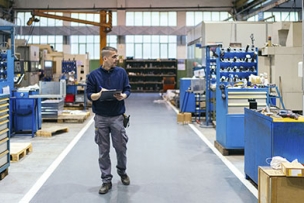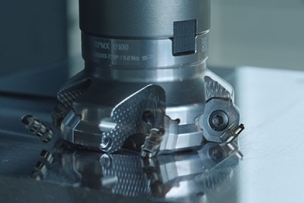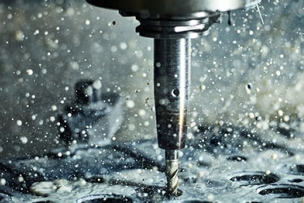Steam soon gave way to compressed air, and for the next 150 years or so, pneumatic power tools have only grown lighter, more powerful, and more energy-efficient. So have electric power tools, which have given their air-powered cousins a run for their money since the advent of widespread electrification.
Don’t Slip
Today, everyone from mechanics and welders to machinists and construction workers can choose from a broad array of both air and electric power tools. Drills and die grinders, impact wrenches, jig saws and riveters—all these and more are readily available, making short work of whatever industrial task awaits. There’s just one problem, though.
“Check the OSHA website and you’ll see that the No. 1 recorded workplace injury is slips, trips and falls,” says Eric Cayne, national accounts manager for Brookfield, Wisconsin-based Milwaukee Tool. “The air hoses or electrical cords running throughout many shops and jobsites are responsible for at least some of this. So, aside from the potential of losing a worker—temporarily or longer—due to injury, the shop also has to bear the cost of higher workers’ compensation rates and insurance premiums after an accident. Battery-powered tools help to avoid all of this.”
He explains that there’s another revolutionary shift in power tools underway—one that should be increasingly obvious to anyone who’s visited the local hardware store recently or cruised the pages of MSC Industrial’s Big Book: tools powered by rechargeable lithium-ion batteries.
Wrist Savers
Battery-powered tools and the rechargeable batteries that keep them operational might not have even been imaginable 150 years ago, but they are leading the current transformation away from air and electric tools.
In fact, market intelligence firm Business Research Insights notes in a recent report that the cordless power tools market in the U.S., valued at approximately $36.52 billion in 2024, is forecasted to hit $60.67 billion by 2033.
This transformation is having a significant impact on the way many workers perform their jobs. “Think about a mechanic removing the lug nuts on a truck wheel,” Cayne says. “There’s not much technology built into a pneumatic impact wrench besides the compressed air and the strength of whoever’s on the business end of it. So what happens if someone sets the torque level too high, or the nut was overtightened to begin with? It might snap your wrist.”
Milwaukee Tool has addressed this potential “machine over human” risk with a feature called ONE-KEY with AutoStop. The technology uses a built-in gyroscopic sensor that detects sudden rotational motion, such as a fast quarter-turn of the wrist. If the tool detects this kickback, it automatically shuts off to protect the user from injury.
“We have AutoStop built into many of our tools, not just our larger impact wrenches,” Cayne adds. “Another area where it’s common is pipe threaders, like those used in the plumbing industry. Some people call them ponies, because they can take you for a ride without the right safety features,” he says, laughing.
Where’s My Tool?
Cayne makes several additional arguments for battery power over air and electric, even though the company still offers some of the latter. Along with the trip hazard that comes with cords and hoses, and the potential pony rides just mentioned, there’s the higher noise level associated with air compressors going on and off all day, as well as the buzz of the miniature turbines contained within all pneumatic tools. That is all alleviated with the use of quieter, cordless battery-powered tools.
In most cases, lithium-ion-powered tools are also lighter than the traditional alternatives, improving ergonomics, reducing fatigue, and easing user adoption. And even though it has nothing to do with how the power tool gets its mojo, Milwaukee Tool also offers a Bluetooth-enabled device tracker similar to the “Find My Device” feature found on many smartphones.
Because you don’t need an air compressor or a continuous electric source with battery-powered tools, they’re very popular for construction work, oil and gas repair, telecom tower installation and repair, railway maintenance, and other jobsites where portability and ease of use are important.
“The problem is that tools on jobsites can grow legs. In this instance, Bluetooth acts like an inventory management system, so you can actually track down the tool or shut it down remotely,” Cayne says. “If someone tries to use the tool after they’ve stolen it, it won’t work, even if they install a brand-new battery. There’s also a chip inside each tool that’s in constant communication with the battery, so as to provide the best performance and life.”
Of course, taking lithium-ion tools on the road presents a different challenge—keeping them charged throughout the day. To meet this need, Milwaukee Tool offers its MX Fuel power supply solution, a large (though still portable) battery unit and charging system that’s “meant to directly replace gas-powered generators.” With that comes the company’s REDLITHIUM FORGE battery packs, which are powerful enough to drive cutoff saws, jackhammers, concrete screeds and vibrators, dewatering units, and other trade-focused tools.
A Compelling Story
Add it all up and it presents a persuasive argument for moving away from pneumatic tools altogether, which Milwaukee Tool did more than a decade ago. Since then, they’ve introduced three systems: the MX Fuel just described, as well as the M18 and M12 product lines.
The latter of these is intended as a replacement for the 200-some air-powered hand tools in the previous M12 line—ratchet screwdrivers, die grinders, angle drills and the like—while the M18’s miter saws, hedge trimmers, and other tools (around 350 in all) straddle the fence between M12 power tools and those found in the MX Fuel offering. Workers can use the batteries in each with any of the tools in that product line.
They’re also backward compatible, although Milwaukee Tool typically kits them with the most appropriately sized battery for that tool.
“Let’s say you’re looking at our 1-inch impact wrench,” he says. “We recommend pairing it with our largest, strongest battery to give you the full 2,000 foot-pounds of available torque. That said, our smallest battery within that series will also work on that tool, although not to the best of its ability.”
As for maintenance, the safety sheet that comes with all Milwaukee battery-powered tools offers several important tips. For example, avoid exposing them to water or rain and do not use oil or solvents to clean or lubricate the battery pack. Similarly, do not store them in damp locations where corrosion of the terminals may occur and, as with other battery pack types, permanent capacity loss can result if the pack is stored for long periods of time at high temperatures (over 49 degrees Celsius).
Says Cayne: “It’s really a matter of making sure you always pair the right battery with the right tool to give you the best performance out there. Aside from that, there’s little to know as far as maintenance, except to keep the batteries on their charger while not in use. That’s it.”
What about shops that want to stick with their tried-and-true pneumatic or electric power tools? Cayne says there are a few sectors where people prefer their legacy hand tools—mechanic shops are one example—but in general, the industry is moving toward lithium-ion batteries given their power, convenience and portability.
“They just solve a lot of problems,” Cayne says.
Has your facility started making the switch to battery-powered alternatives? What’s driving your decision? Tell us in the comments below.





Talk to Us!
Leave a reply
Your email address will not be published. Required fields are marked *